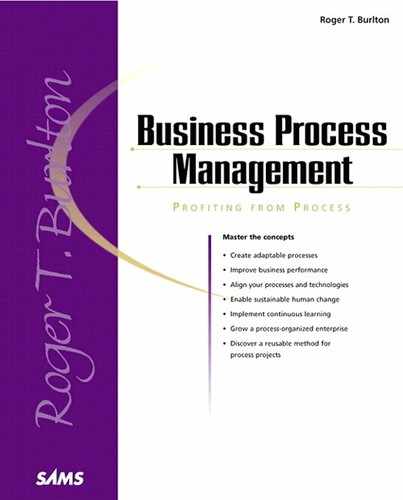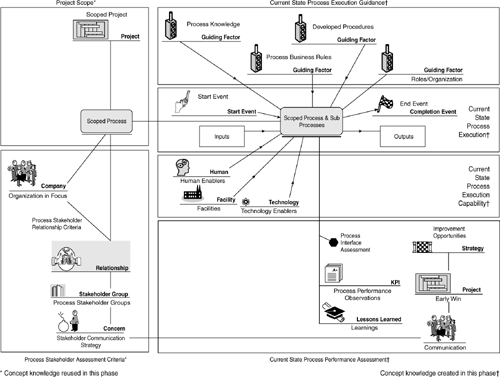Understanding the Existing Process
The purpose of the Understand phase is to gain a sufficient understanding of the current situation so that a baseline for change can be established. In this phase, an organization documents and validates its current reality and defines its improvement priorities. It isn’t the purpose of this phase to deliver detailed perfect knowledge—just enough to be confident to move into solution creation.
Results
During the Understand phase, an organization seeks to deliver a common understanding of what the existing process actually does so that the right improvements can be made and perceptions managed. It measures actual performance levels and documents what works well and not so well today. Based on this, it determines the required changes and implements some immediate improvements where feasible.
Concepts Handled
Figure 5.8 depicts the concepts dealt with the Understand phase.
Concept Knowledge Reused
The knowledge gained in the Vision phase will apply directly in the Understand phase. Without this basis, the work here will be a disaster. I can guarantee that it will wander aimlessly and be fraught with politicking and confusion. Aspects of the relationship criteria and scoping are especially important.
The interactions and flows between the process-in-focus and its stakeholders actually define the process’s outcomes. The principles, expectations, performance targets, and future CSFs are all reference points of comparison to assess the current state’s gaps in effectiveness and efficiency.
The stakeholder group’s concerns must be responded to all the way through the Understand phase via a well-executed communication program.
Concept Knowledge Created
Starting with an understanding of the results of the Vision phase and a validation of the scope produced there, you should first focus on attaining a good definition of the current state process execution. In other words, get a clear understanding of what triggers each activity in the process and what inputs are available when it occurs. Also look at the outputs created and define the closing event that indicates the process activity’s completion. This must be what actually goes on, not what people would like you to believe.
While looking at the input-process-output flow, also discover what’s used to guide the current state execution. Find the actual types of knowledge used, whether tacit or explicit, available or hard to find. Identify the actual rules applied to the work’s decision-making. Review procedures to see how frequently they are followed. Look at the roles and responsibilities of those doing the work and document the organizational units that they report to.
Examine the reusable current state capabilities and the enterprise assets. Look at the humans doing the work. Examine the technologies automating information management or providing embedded knowledge access or rules execution. Walk through the facilities and equipment used to conduct non–information-oriented tasks as well as those required to support knowledge workers.
Throughout the Understand phase, as you delve into the process in more depth, ask lots of questions. Investigate how well each interfacing step, input, guide, output, and enabler contributes toward the objectives of the process today and also how well it would meet the process stakeholder relationship criteria for the future. Measure the current process observations against the key performance indicators defined and evaluate the gap in the performance expected in the future.
Search hard for lessons learned about what’s poor, good, and great practice from those who currently do the work and also understand the need to change. From these lessons, identify improvement opportunities. Some will be long term and require full process redesign in the Renew phase; others will be attainable in the short term. These quick wins will require a low effort and will face little resistance. Implement them as fast as you can.
Take all your understanding, findings, and opportunities and develop regular communications for the stakeholders according to the schedule and frequency of the communication strategy. Communicate them early and often to help staff navigate the change journey. You will regret it later if you don’t.
Steps
The following steps are recommended to populate the concepts of this phase (they are described in detail in Chapter 13, “Understanding the Existing Situation”):
1. | Confirm scope and boundaries. |
2. | Map existing process understanding. |
3. | Measure process performance. |
4. | Determine root causes. |
5. | Identify improvement priorities. |
6. | Implement early wins. |

